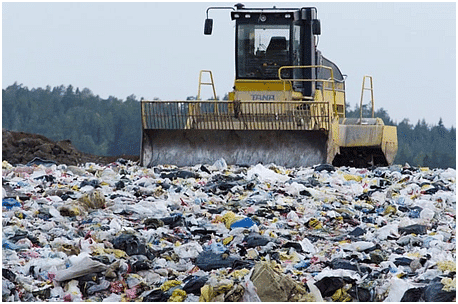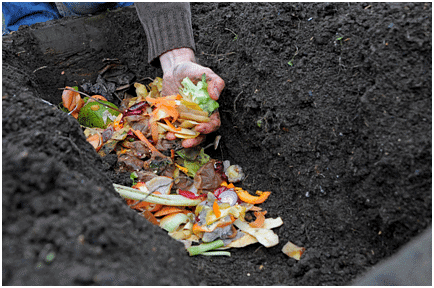Conservation of Environment Class 5 Notes SST
| Table of contents |

|
| Introduction |

|
| Types of Waste |

|
| Methods of Waste Disposal |

|
| The Three R's: Recycle, Reduce, and Reuse |

|
Introduction
The environment we live in consists of both living and non-living elements. Everything we observe on Earth constitutes our environment. It encompasses various components such as houses, buildings, people, animals, temperature, water, light, and other living and non-living entities.
Plants, for instance, rely on non-living things like water, air, and sunlight for their survival. Similarly, human beings also depend on water, air, and heat energy. Maintaining a balance between the living and non-living aspects is crucial for a healthy environment that allows coexistence.
A clean environment plays a vital role in promoting good health, while an unclean and dirty surrounding can be a breeding ground for germs, diseases, and environmental degradation. Any alteration in the environment affects the lives of all living beings. Therefore, it becomes imperative to protect and take care of our environment.
Keeping the Environment Clean
To create a cleaner and better environment for all living things, it is essential to adopt certain practices:
- Proper waste disposal: It is crucial not to throw waste or household garbage carelessly on streets, planes, or open drains. Instead, waste should be disposed of in designated garbage bins.
- Public sanitation: Roads, streets, and public places should not be used as toilets. Public toilets should be utilized and kept clean.
- Use of eco-friendly bags: Instead of using polythene or plastic bags, paper or cloth bags should be preferred for carrying goods.
- Preventing stagnant water: Drains, puddles, and coolers should not be allowed to accumulate stagnant water, as they become breeding grounds for mosquitoes.
Types of Waste
The amount of waste produced by human beings is enormous. It has been estimated that a single person generates garbage approximately ten times his or her body weight over the years. Waste can be categorized into two types:
- Biodegradable Waste: This type of waste includes leftover food, vegetable or fruit peels, paper, fallen leaves, petals, and twigs from plants. Biodegradable waste can be decomposed by bacteria and earthworms, and it can be safely mixed with soil to enhance fertility.
- Non-biodegradable Waste: Non-biodegradable waste consists of materials that do not decompose easily or integrate with the soil. Examples of non-biodegradable waste include plastic items, cans used for aerated drinks, and silver foil used for food packaging. These materials take hundreds or thousands of years to decompose and can cause harm to the environment by clogging drains and harming water creatures.
Methods of Waste Disposal
In large cities, local agencies are responsible for the collection and disposal of waste. Different methods are employed for waste disposal:
1. Burning: Waste is collected and burned. However, burning waste causes air pollution and is detrimental to the environment, especially when toxic waste is involved. 2. Dumping: Waste is transported by trucks to distant locations outside towns or cities and dumped into open areas. However, this process also pollutes the environment and creates breeding grounds for rodents, mosquitoes, and various germs.
2. Dumping: Waste is transported by trucks to distant locations outside towns or cities and dumped into open areas. However, this process also pollutes the environment and creates breeding grounds for rodents, mosquitoes, and various germs. 3. Landfills: Landfills are the most commonly used method of waste disposal. These are deep ditches dug in the outskirts of cities where garbage is dumped. Once full, the ditches are covered with soil, and the area can later be converted into a park or playground.
3. Landfills: Landfills are the most commonly used method of waste disposal. These are deep ditches dug in the outskirts of cities where garbage is dumped. Once full, the ditches are covered with soil, and the area can later be converted into a park or playground.
4. Compost Pits: In rural areas, pits are dug in the ground to dump household waste. Over time, this waste decomposes and transforms into nutrient-rich manure called compost. Farmers use this compost in their fields, and the crops grown using this natural fertilizer are known as organic food.
The Three R's: Recycle, Reduce, and Reuse
To live in a clean environment, it is crucial to understand and adopt the principles of the Three R's:
- Recycling: Recycling is a process in which waste materials are treated to be reused. Items such as paper bags, cans, milk cartons, and certain types of plastic and glass bottles can be recycled. For example, old paper can be used to produce new paper, and plastic waste can be transformed into various usable products. Recycling also extends to water, where it can be treated and reused for purposes like watering plants.
- Reuse: Rather than discarding items, it is important to find ways to reuse them. Avoid using disposable items whenever possible and carry reusable mugs, eating utensils, and shopping bags. Donating old clothes, toys, and furniture is also a way to promote reuse. Additionally, using both sides of writing paper and repurposing paper grocery bags for book covers can help reduce waste and save trees.
- Reduce: The most effective way to protect the environment is to reduce the amount of waste generated. This can be achieved by using alternative transportation methods such as carpooling, walking, or taking public transportation. Conserving energy by turning off lights and faucets when not in use, as well as purchasing products with minimal packaging, also contribute to waste reduction. It is worth noting that packaging accounts for over 30% of the total waste produced.
Conclusion
Conserving the environment is essential for the well-being of all living beings. By adopting responsible waste disposal practices, understanding the different types of waste, and implementing the Three R's (Recycle, Reduce, and Reuse), individuals can contribute significantly to maintaining a clean and sustainable environment. A collective effort toward conserving our environment will ensure a healthier and brighter future for generations to come.
|
33 videos|264 docs|50 tests
|















